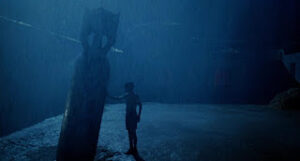Module: Screening Europe
Module Coordinator: Dr Emma Austin
Academic Year 1 (2020/2021)
This is the fifth of six blog post essays for the module Screening Europe. I enjoyed writing this, as I have a particular interest in Guillermo del Toro’s films and had taken on feedback from previous posts to improve my work. Please note that learningonscreen.ac.uk is an academic video sharing platform and simply including the links in the way I have without an embedded video was accepted.
Featured Image (IMDb, n.d.)
Guillermo del Toro is known for creating fantastical tales of conflict – whether it is humanity’s fight for survival against the Kaiju in Pacific Rim (2013), Hellboy’s discovery of his origins in Hellboy (2004), or Ofelia’s desire to escape reality in Pan’s Labyrinth (2006), there is always some form of conflict which is central to the premise of the film.
The Devil’s Backbone (del Toro, 2001) is a ghost story surrounding the lives of seven orphan boys and the people who look after them, set in 1939, during the final year of the Spanish Civil War.
Carlos, a 12-year-old boy whose father has died in the war, is delivered to the Santa Lucia orphanage by his tutor and is immediately fascinated by a towering bomb wedged vertically in the centre of the courtyard. The lives of everyone living in the orphanage seem to revolve around this bomb. Keith McDonald and Roger Clark noting in their 2014 book:
The bomb also carries a symbolic payload of trauma as a signifier of the memory of war that can never fully be ‘defused’ or repressed, not only the ‘silenced horrors of the Spanish Civil War’ that have been supposedly ‘dealt with’ in Spanish political, historical and cultural memory, but also the spectre of ongoing twenty-first-century wars in which dead children are often the tragic but invisible collateral damage. (pp. 141-142).
‘Carlos’s first encounter with the bomb’, The Devil’s Backbone, 01:30 01/11/2014, BBC2 England, 100 mins. 00:04:49-00:05:49. https://learningonscreen.ac.uk/ondemand/index.php/clip/199160?bcast=114425529
The orphanage is situated in the middle of the desert, an intentional aspect of the story. In an interview with Matt Zoller Seitz, del Toro explained why:
But in the case of The Devils Backbone, I wanted a landscape with nothing around it. Literally, nothing. Distant mountains, if any at all, and a single building in the middle of it all, so that you understand, visually, that war is far away. It is nowhere near that building.
And yet, it is in the hearts and pulses of every character in that orphanage. The character of Jacinto, for instance, is representative of the way I understand nascent fascism. (2017, p. 32).
In an interview with Kimberly Chun, del Toro explains his use of a ghost story running alongside the Spanish Civil War: “Also the whole idea was to create a ghost story where the war was a background but eventually crept into the foreground.” (2009, p.29).
Later we learn that a boy named Santi disappeared the same night the bomb fell and that his ghost is rumoured to haunt the orphanage. Jaime reveals he saw Jacinto kill Santi and that his ghost remains. Carlos asks the bomb where the ghost is and a red ribbon, symbolic of Santi’s spilled blood, shows him the way into the cellar.

Later it becomes clear Jacinto is an evil man consumed by his lust for the gold bars locked in the safe and the ghost’s warning of “Many of you will die” is realised when Jacinto’s last attempt to open the safe results in an explosion that kills many of the people around it. Their deaths represent and replace the devastation the bomb failed to deliver.
Anne E. Hardcastle raises an interesting point:
Carlos (like the young, democratic Spain he represents) has neither participated in nor witnessed the trauma that initiates the film, the dual horror of the bombing in Santi’s murder. Instead, his courage and distance from the events allow him to save Jaime, uncover the past, and restore justice to the ghost’s memory. (2005, p. 123).
Santi’s ghost never posed a real threat to Carlos or the boys, and his warning could have been an attempt to save the boys from Jacinto’s, and the war’s, evil. Hardcastle further states: “By now all the boys have realized that it is the living, not the dead, that threaten Santa Lucia.” (2005, p. 123).
By now the film has evolved from mainly being a ghost story to symbolising the struggles of the war with the orphans and Jacinto portrayed as opposing sides of the war. The conflict within the orphanage represents the fact that even though they are far from the war itself, the war affected the lives of everyone in Spain in some way or another.
Citations
- Chun, K. (2002). What is a Ghost?: An Interview with Guillermo del Toro. Cineaste, 27(2), 29.
- del Toro, G. (Director). (2001). The Devil’s Backbone [Film]. El Deseo; Tequila Gang; Sogepaq.
- del Toro, G. (Director). (2004). Hellboy [Film]. Revolution Studios; Lawrence Gordon Productions; Starlite Films.
- del Toro, G. (Director). (2006). Pan’s Labyrinth [Film]. Tequila Gang; Estudios Picasso; Esperanto Filmoj.
- del Toro, G. (Director). (2013). Pacific Rim [Film]. Warner Bros.; Legendary Entertainment; Double Dare You (DDY).
- Hardcastle, A. E. (2005). Ghosts of the Past and Present: Hauntology and the Spanish Civil War in Guillermo del Toro’s ‘The Devil’s Backbone’. Journal of the Fantastic in the Arts, 15(2), 123.
- IMDb. (n.d.). The Devil’s Backbone Cover Poster. IMDb. https://www.imdb.com/title/tt0256009/
- McDonald, K., & Clark, R. (2014). Guillermo del Toro. Film as alchemic art. Bloomsbury Publishing Inc.
- Zoller Seitz, M. (2017). Guillermo del Toro’s The Devil’s Backbone. Titan Publishing Group Ltd.